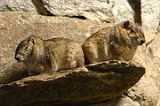
Rock Cavy
Encyclopedia
The rock cavy or mocó, Kerodon rupestris, is a cavy species
endemic
to eastern Brazil
, from eastern Piauí
state to Minas Gerais
state. It has been introduced to the oceanic island of Fernando de Noronha
.
Rock cavies are found in dry rocky areas, with low scrubby vegetation, and close to stony mountains and hill
s, resembling another (only distantly related) creature, the Rock Hyrax
. They usually shelter in crevices and are territorial animals, defending rock piles against other adult males.
The rock cavy is a fairly large rodent weighing up to 1 kilograms (2.2 lb) and, as in other cavies, the tail is vestigial or absent. The dorsum
is grey and the venter
light brown.
They feed on seed and leaves of the scrubby vegetation that grows in their territory. They live in groups and give birth to one or two young only, but several litters per year are common. The gestation period averages seventy-five days. They can, sometimes, display homosexual behavior with adult males courting juvenile males. Each group has an alpha or dominant male and several females.
Rock cavies are common animals, even though they are frequently hunted for food by local human populations.
Species
In biology, a species is one of the basic units of biological classification and a taxonomic rank. A species is often defined as a group of organisms capable of interbreeding and producing fertile offspring. While in many cases this definition is adequate, more precise or differing measures are...
endemic
Endemic (ecology)
Endemism is the ecological state of being unique to a defined geographic location, such as an island, nation or other defined zone, or habitat type; organisms that are indigenous to a place are not endemic to it if they are also found elsewhere. For example, all species of lemur are endemic to the...
to eastern Brazil
Brazil
Brazil , officially the Federative Republic of Brazil , is the largest country in South America. It is the world's fifth largest country, both by geographical area and by population with over 192 million people...
, from eastern Piauí
Piauí
Piauí is one of the states of Brazil, located in the northeastern part of the country.Piauí has the shortest coastline of any of the non-landlocked Brazilian states at 66 km , and the capital, Teresina, is the only state capital in the north east to be located inland...
state to Minas Gerais
Minas Gerais
Minas Gerais is one of the 26 states of Brazil, of which it is the second most populous, the third richest, and the fourth largest in area. Minas Gerais is the Brazilian state with the largest number of Presidents of Brazil, the current one, Dilma Rousseff, being one of them. The capital is the...
state. It has been introduced to the oceanic island of Fernando de Noronha
Fernando de Noronha
Fernando de Noronha is an archipelago of 21 islands and islets in the Atlantic Ocean, offshore from the Brazilian coast. The main island has an area of and had a population of 3,012 in the year 2010...
.
Rock cavies are found in dry rocky areas, with low scrubby vegetation, and close to stony mountains and hill
Hill
A hill is a landform that extends above the surrounding terrain. Hills often have a distinct summit, although in areas with scarp/dip topography a hill may refer to a particular section of flat terrain without a massive summit A hill is a landform that extends above the surrounding terrain. Hills...
s, resembling another (only distantly related) creature, the Rock Hyrax
Cape Hyrax
The Rock Hyrax , or Cape Hyrax, is one of the four living species of the order Hyracoidea, and the only living species in the genus Procavia. Like all hyraxes, it is a medium-sized terrestrial mammal, superficially resembling a guinea pig with short ears and tail...
. They usually shelter in crevices and are territorial animals, defending rock piles against other adult males.
The rock cavy is a fairly large rodent weighing up to 1 kilograms (2.2 lb) and, as in other cavies, the tail is vestigial or absent. The dorsum
Dorsum (biology)
In anatomy, the dorsum is the upper side of animals that typically run, fly, or swim in a horizontal position, and the back side of animals that walk upright. In vertebrates the dorsum contains the backbone. The term dorsal refers to anatomical structures that are either situated toward or grow...
is grey and the venter
Venter
Venter is a surname, and may refer to:* Brendan Venter - Rugby union footballer* Christoffel Venter - South African military commander* Craig Venter - American biologist and businessman...
light brown.
They feed on seed and leaves of the scrubby vegetation that grows in their territory. They live in groups and give birth to one or two young only, but several litters per year are common. The gestation period averages seventy-five days. They can, sometimes, display homosexual behavior with adult males courting juvenile males. Each group has an alpha or dominant male and several females.
Rock cavies are common animals, even though they are frequently hunted for food by local human populations.

